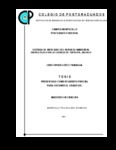| dc.description.abstract | Se realizó un estudio de mercado de los servicios ambientales hidrológicos (SAH) en la cuenca de Tapalpa, Jalisco, México, cuya superficie es de 21,000 ha, donde el 44% es de uso forestal. Para determinar la oferta hidrológica se utilizó el modelo hidrológico SWAT (soil and water assesment tool, herramienta de valoración de suelo y agua) que presentó un buen ajuste (R2 = 0.85) al ser calibrado con la producción de agua en una de las cinco subcuencas que integran el área de estudio. El análisis de demanda indica que existe un superávit del recurso hídrico (19,792,015 m3/año), ya que solamente se aprovecha el 54% (23,171,885 m3/ha) de la oferta total (42,963,900 m3/ha). De ésta, el 93% seutiliza en el sector agrícola, principalmente en la producción de hortalizas (50%) y cultivos básicos (23%). En cuanto a la disponibilidad a pagar (DAP) por el SAH, se encontró que ésta es mayor en el sector servicios (76.7% respondieron afirmativamente). Sin embargo, la mayor participación monetaria en la DAP total estuvo dada por el sector doméstico, (46.5% del total), que asciende a $3,064,301.88/año. El valor de la DAP total fue menor que el costo de oportunidad para conservar la superficie boscosa de la cuenca, con un déficit anual de $27,201,313.4. La DAP sólo cubrió el 10% de dicho costo de oportunidad. Al agregar el costo asociado a la recuperación de la superficie en conflicto, el déficit anual aumentó a $45,130,987.7 y la DAP se reduce a sólo el 6% del costo de oportunidad total. Al proyectar la demanda y oferta, suponiendo un incremento acumulado de la demanda del 40% y un decremento acumulado del 37% para la oferta en los próximos 20 años, se observó que la cantidad ofertada será incapaz de satisfacer la cantidad demandada en el año 2021, existiendo un déficit del recurso hídrico del orden de 735,280 m3/año, representando el 2.4% de la cantidad demandada para ese año (30,440,928 m3/año)._______A market study of the hydrologic environmental services (HES) was carried out in the Tapalpa watershed at Jalisco, Mexico, and has 21,000 ha, where 44% is forest land. To determine the hydrologic supply SWAT (soil and water assessment tool) was used, and displayed a good fit (R2 = 0.85) when it was calibrated, using water yield, in one of the five sub-watersheds that define the study area.
The demand analysis indicated that exist a superávit of the hydric resource (19,792,015 m3/year); only 54% (23,171,885 m3/ha) of total supply (42,963,900 m3/ha) is used. 93% of the water demanded is used by the agriculture sector, mainly in vegetables production (50%) and basic crops (23%). Regarding the willingness to paid (WTP) for the HES, it was found higher in the services sector (76.7% of the cases showed WTP). However, the biggest monetary participation in total WTP was given by the domestic sector, with 46.5% of the total, which ascends to $3,064,301.88/year. Total WTP was less (only 10%) than the estimated opportunity cost to conserve forestry cover in the watershed, resulting in an annual deficit of $27,201,313.40. When the cost associated to reconvert (change agriculture or another land use to forest use) the existing area under conflictive use was added, the annual deficit increased to $45,130,987.7 and WTP is reduced to only 6% of total opportunity cost. When demand and supply were projected—increasing demand in 40% and decreasing supply in 37% in the next 20 years- it was found that the supply will not be enough to cover the water consumption in 2021. A deficit of 735.28 thousand of m3/year was found. This figure represents 2.4% of the estimated demand for 2021 (30,440,928 m3/year). | es |


